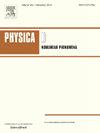Shock waves in an ideal gas with variable density, the radiative and conductive heat fluxes in the presence of gravitational force and magnetic field via the Lie group technique
IF 2.7
3区 数学
Q1 MATHEMATICS, APPLIED
引用次数: 0
Abstract
In our study, we have investigated the spherical (or cylindrical) shock waves propagation in an ideal gas with heat conduction and radiation heat flux in the presence of gravitational force and azimuthal magnetic field via the Lie group transformation technique. In this article, the heat conduction is described using Fourier’s law for heat conduction. In the case of thick gray gas model, the radiation is treated as of the diffusion type. The absorption coefficient and the thermal conductivity are considered to depend on some specific powers of density and temperature. By utilizing the Lie group transformation technique, four potential similarity solution cases were identified, in which the similarity solution exist in only one case (i.e., Case I). In this case, the shock radius follows a power law dependence on time. For this case, the similarity solutions are derived for the flow region behind the shock front, and the impact of problem physical parameters on the flow variables and on the shock strength are studied in detail. The results of this study offer a clear understanding of the influence of radiative and conductive heat transfer parameters, the gravitational parameter, the similarity exponent, and the magnetic field on the shock and on the flow dynamics behind the shock front. It is found that the shock wave decays with an increment in shock Cowling number or the heat transfer parameters or gravitational parameter. On increasing the value of similarity exponent, the strength of the shock wave increases in the non-magnetic case; whereas in the magnetic case, the shock strength reduces. It is also observed that, the shock strength is enhanced, when we change the geometry from cylindrical to spherical.
利用李群技术研究了变密度理想气体中激波在重力和磁场作用下的辐射热流和导热热流
在本研究中,我们利用李群变换技术研究了在重力和方位磁场作用下,具有热传导和辐射热流的理想气体中的球形(或圆柱形)激波传播。本文用傅立叶导热定律来描述热传导。对于厚灰气体模型,辐射被视为扩散型。吸收系数和导热系数被认为取决于密度和温度的某些特定幂。利用李群变换技术,确定了四种潜在的相似解情况,其中只有一种情况(即情况I)存在相似解,在这种情况下,冲击半径随时间服从幂律。针对这种情况,导出了激波前缘后流动区域的相似解,并详细研究了问题物理参数对流动变量和激波强度的影响。本研究的结果清晰地揭示了辐射传热和传导传热参数、重力参数、相似指数和磁场对激波和激波锋后流动动力学的影响。研究发现,激波随激波罩数、传热参数和重力参数的增加而衰减。随着相似指数值的增大,无磁情况下激波强度增大;而在磁性情况下,冲击强度降低。我们还观察到,当几何形状由圆柱形变为球形时,冲击强度有所提高。
本文章由计算机程序翻译,如有差异,请以英文原文为准。
求助全文
约1分钟内获得全文
求助全文
来源期刊

Physica D: Nonlinear Phenomena
物理-物理:数学物理
CiteScore
7.30
自引率
7.50%
发文量
213
审稿时长
65 days
期刊介绍:
Physica D (Nonlinear Phenomena) publishes research and review articles reporting on experimental and theoretical works, techniques and ideas that advance the understanding of nonlinear phenomena. Topics encompass wave motion in physical, chemical and biological systems; physical or biological phenomena governed by nonlinear field equations, including hydrodynamics and turbulence; pattern formation and cooperative phenomena; instability, bifurcations, chaos, and space-time disorder; integrable/Hamiltonian systems; asymptotic analysis and, more generally, mathematical methods for nonlinear systems.
 求助内容:
求助内容: 应助结果提醒方式:
应助结果提醒方式:


